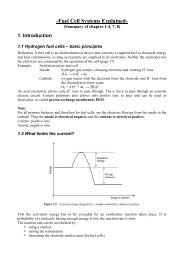Chapter 8. ORGANIC SOLAR CELLS - from and for SET students
Chapter 8. ORGANIC SOLAR CELLS - from and for SET students
Chapter 8. ORGANIC SOLAR CELLS - from and for SET students
You also want an ePaper? Increase the reach of your titles
YUMPU automatically turns print PDFs into web optimized ePapers that Google loves.
2.2. C-SI TECHNOLOGY CHAPTER 2. C-SI TECHNOLOGY<br />
2.2.2 Production of Si<br />
Figure 2.2: Concentration at surface <strong>and</strong> in the bulk<br />
Due to the learning curve the prices of solar cell dropped. However only in 2005 there was an increase in solar<br />
cell costs which is due to the fact that not enough production capacity <strong>for</strong> c-Si was there.<br />
The silicon is roughly 40 percent of the total cost of the solar module. Common materials that are used are<br />
mono crystalline, multi crystalline <strong>and</strong> amorphous silicon. The material has a cubic diamond structure <strong>and</strong> one<br />
can state that the main material used is the multi crystalline silicon.<br />
Processing <strong>and</strong> refining<br />
Silicon in its basic <strong>for</strong>m is s<strong>and</strong>. In a furnace of roughly 1900 degrees Celsius the SiO2 is added with 2 C atoms<br />
leading to SI <strong>and</strong> 2 CO. This already gives a purity of roughly 98 %. This is however not enough, to further<br />
refine the metallurgical silicon the silicon is converted into compound <strong>and</strong> then this is converted back to pure<br />
silicon. Further refining can be done by using czochralski casting which first melts down the silicon in a crucible,<br />
then a seed crystal is dipped into the silicond, the slowly the seed is pulled upwards <strong>and</strong> rotated at the same<br />
time. This results in a large singly crystal ingot.<br />
Description Symbol Grain Size Common Growth Technique<br />
Single Crystal Sc-Si greater than 10 cm Czochralski Float zone<br />
Multicrystalline mc-Si 1 mm - 10 cm Cast Sheet Ribbon<br />
Polycrystalline pc-Si 1 µ - 1mm Chemical vapour deposition<br />
Microcrystalline µc-Si smaller than 1 µm Plasma deposition<br />
Czochralski casting<br />
Another process is zone float pulling in which oxygen impurities reduce the minority carriers lifetime. The<br />
impurities stay in the molten region, thereby purifying the material. Also multi crystalline ingot casting can<br />
be used in which crucibles are are filled with silicon <strong>and</strong> the required dpoants (boron), the molten silicon is<br />
slowly cooled down to get large grain. Another highly effective method is silicon ribbon in which a temperature<br />
resist<strong>and</strong> wire is pulled through a crucible of molten silicon, however this leads to more defects. The procedure<br />
can be seen in figure 2.3.<br />
11






